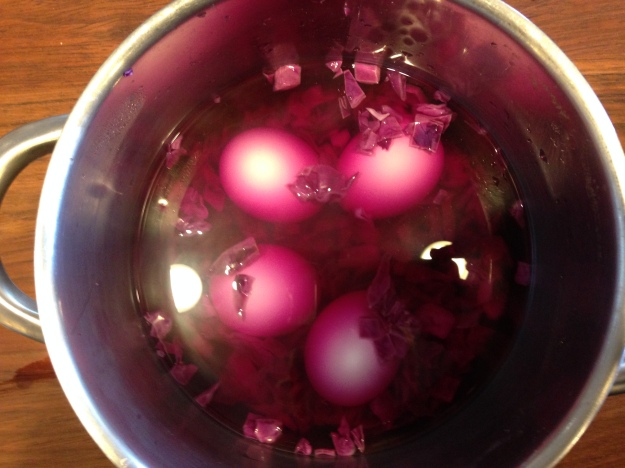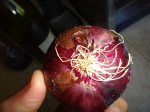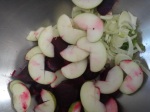Dying Easter eggs with homemade vegetable dyes today made for some superb kitchen botany. Making the dyes is easy, fun, and offers insight into the fascinating evolution of plant pigments.

Pigments serve a variety of roles in plants. Many pigments protect plant tissues from sunburn and pathogens and herbivores or perform other physiological functions (see review by Koes et al. 2005). Most noticeably, however, their brilliant colors attract animal pollinators to flowers and seed dispersers to fruit. Humans are also interested in plant pigments, which color and sometimes flavor our food, are potentially medicinally active, and have been used as natural dyes and paints for millennia.
Today we made green dye from parsley, two different yellow dyes from turmeric and yellow onion skin, and three different pinkish-purplish dyes, from red cabbage, red onion skin, and beets. The basic recipe for all the vegetable dyes is the same: coarsely chop the vegetables, pour boiling water over it (about 2 cups vegetables or 1 tablespoon turmeric powder per quart of water), and stir in white vinegar (about a tablespoon per quart). Alternatively, put the chopped vegetables in a saucepan, cover with the water, and bring to a boil. You can either immediately add the hard-boiled eggs to the vegetable soup and let it sit for 12-48 hours, or you can let the vegetables steep for an hour and strain the vegetable solids out before adding the eggs and letting it sit.
The green color from the parsley comes from the pigment chlorophyll, a key component of the light-harvesting function of the photosynthetic apparatus. Grinding the parsley in the blender released the chlorophyll from the chloroplasts.
The spice turmeric comes from the rhizome (underground stem) of Cucurma longa (family Zingiberaceae), native to tropical southeastern India. Much (if not all) of turmeric’s yellow-orange color (and its distinctive earthy flavor) comes from its curcuminoids, natural phenols. These are likely defensive compounds that help the plant thwart herbivores and pathogens.
Curcuminoids are not widespread among plants, unlike other yellowish pigments, most notably the hydrocarbon carotenoids (xanthophylls and carotenes, including vitamin A precursors). The yellow-orange color of the yolks inside our Easter eggs came from the xanthophylls lutein and zeaxanthin that the chickens obtained from their food, ultimately from plant sources. Xanthophylls provide sunscreen to leaves. Carotenes have photosynthetic roles, but they’re mostly known for the color they give to many plant structures. Most carotenes confer yellow or orange color, but the carotene lycopene is bright red and is a primary pigment of tomatoes, red carrots, watermelons, and papayas. Although carotenoids are common, I don’t know much about their use as a dye. The yellow color from the yellow onion skins came not from carotenoids but from oxidative byproducts of flavonoid pigments, notably quercetin.
Red cabbage and red onion get their purple color from anthocyanins, the most common purple and blue pigments found in nature. Beets, however, get their red and yellow colors from betalain pigments, which replace anthocyanins, and to some extent carotenoids, as a pigment source in most families in the botanical order Caryophyllales (see our Food Plant Tree of Life phylogeny page for details on phylogenetic placement of the Caryophyllales; and see this excellent article for the comparative biology of anthocyanins and betalains within the Caryophyllales). That may initially sound obscure, but there are a lot of food plants in the Caryophyllales, all with betalains instead of anthocyanins (See our Food Plant Tree of Life list).
Extra Credit: At some point in your primary education you may have done a chemistry lab (like this one) using red cabbage-derived anthocyanins to learn about pH, as the anthocyanins can display an impressive range of color depending on pH. The acid (vinegar) in the dye may complicate this plan, but I wonder if there is a way to take advantage of the pH-sensitivity of anthocyanin pigments in dye making.





Very concise and informative article. I enjoyed it very much!
LikeLike
Very good article. Love, Dad.
LikeLike
Wonderful info, thanks! Just a few practical (and maybe silly, but there you go) questions…
– Eggs: peeled, with their shell still on, either one?
– 2 cups of vegetable per quarter… quarter of what? (I’m used to the metric system, so volumes that should be evident for any other reader are confusing to me; the cups and tablespoons I get, but the rest…)
– “Sitting” time: in both cases, 12 to 48 hours?
– Turmeric ratio: uhm, 2 cups of turmeric sounds like a looot of it… (btw turmeric was also used in litmus papers to check pH!)
Thanks a lot!
LikeLike
Thank you for the feedback and questions. My answers:
–Keep shells on
–That’s quart, not quarter, nearly a liter
–Yup, keep all of it in the dye for at least 12 hours, the longer the time the richer the color
–Good catch on the turmeric volume. I’ve edited that section of the text. Very cool about turmeric being a pH indicator! I’d like to learn more about that.
LikeLike